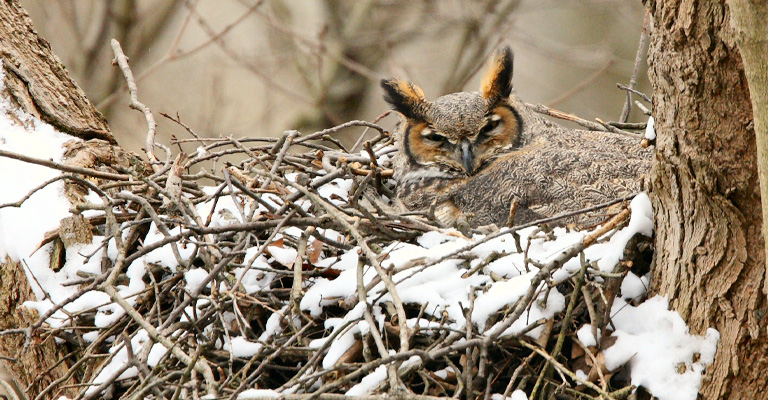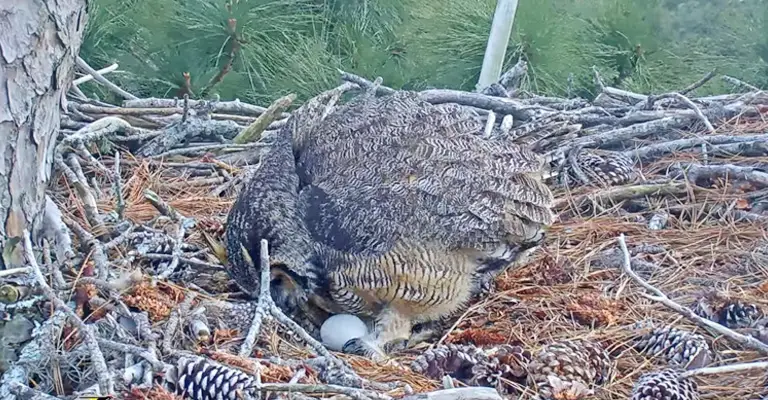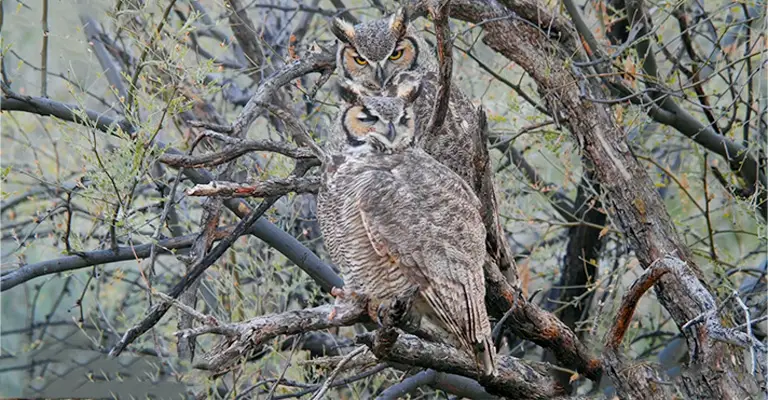In the hushed depths of North America’s vast forests and woodlands, a captivating and enigmatic world comes to life each year. It’s a world where silent shadows and piercing amber eyes dominate the night.
Welcome to the realm of the Great Horned Owl, one of nature’s most formidable and mysterious raptors. Nesting high in the towering trees, these magnificent birds of prey bring a touch of intrigue and majesty to the wilderness.
As dusk falls, they emerge from their hidden roosts, their deep hoots resonating through the darkness, announcing their presence to the realm. Join us as we embark on a journey deep into the heart of the Great Horned Owl nesting.
We’ll unravel the secrets of their elaborate rituals and the challenges they face in rearing their young amidst the harsh realities of the wild.
Through the lens of science and the magic of storytelling, we’ll explore their fascinating behaviors, their fierce dedication to family, and the vital role they play in maintaining the delicate balance of the ecosystems they call home.

Great Horned Owl Nesting
The Great Horned Owl (Bubo virginianus) is a magnificent bird of prey known for its adaptability, strength, and impressive nesting habits.
These powerful raptors are found throughout North and South America, inhabiting a wide range of environments, from dense forests to open deserts.
Nesting is a critical aspect of their life cycle, and it offers valuable insights into their behavior and ecology.
Habitat Selection
Great Horned Owls are known for their versatility in choosing nesting sites. They are not particularly picky when it comes to habitat selection, which contributes to their widespread distribution.
Common nesting locations include tree cavities, abandoned hawk or crow nests, cliffs, and even the nooks of buildings. The selection of a nesting site primarily depends on the availability of suitable locations within their territory.
Nest Construction
The Great Horned Owl is not known for its nest-building skills. Unlike some other bird species that construct intricate nests, these owls prefer to adopt pre-existing structures or use natural cavities.
They rely on their talons to secure themselves within these locations, which is especially important during incubation and when raising their young.
Timing
The timing of Great Horned Owl nesting varies depending on their geographical location. In southern regions, they may start nesting as early as December, while in colder northern areas, nesting typically begins in late February or March.
This timing allows them to take advantage of prey availability, ensuring a steady food supply for their growing chicks.
Reproduction
Great Horned Owls are monogamous and form long-term pair bonds. They often return to the same nesting site year after year, adding to and refurbishing the nest as needed.
The courtship process involves vocalizations and displays, such as hooting and synchronized aerial acrobatics, to strengthen the pair’s bond.
Egg Laying and Incubation

Once a suitable nesting site is selected, the female typically lays 1 to 4 eggs. These eggs are large, round, and white.
Incubation lasts approximately 30 to 37 days, and during this time, the female is primarily responsible for keeping the eggs warm. The male assists by hunting and bringing food to the female on the nest.
Nestling Development
After hatching, the young owlets are altricial, meaning they are born helpless and rely entirely on their parents for food and protection.
As they grow, their plumage gradually changes from fluffy down to juvenile feathers. The parents continue to provide food for the nestlings, and the female often remains with them while the male hunts.
Fledging
Around 6 to 7 weeks after hatching, the young owls begin to leave the nest, a process known as fledging. They may still rely on their parents for food and protection for several weeks after leaving the nest, as they develop their hunting skills.
This extended period of parental care is essential for the survival of the young owls.
Parental Roles
Both parents play crucial roles in raising their offspring. The female primarily stays with the nest and chicks, ensuring their safety and warmth, while the male is responsible for hunting and providing food for the family. This division of labor is vital for the success of the nesting season.
Threats to Nesting Success
While Great Horned Owls are formidable predators, their nests and young are not immune to threats. Nest predation by other animals, such as raccoons, squirrels, and even other owls, can pose a significant risk to nestlings.
Additionally, human disturbance and habitat loss can disrupt their nesting success.
Conservation
The Great Horned Owl is not currently listed as a species of concern, but its conservation status is closely monitored. Protecting their nesting habitats and minimizing disturbances during the breeding season are essential steps in ensuring their continued well-being.
Do Great Horned Owls Mate for Life?

Yes, Great Horned Owls (Bubo virginianus) are known for forming strong and long-lasting pair bonds, often leading to monogamous mating for life.
This enduring partnership plays a crucial role in their reproductive success and the survival of their young. Let’s delve deeper into the fascinating world of Great Horned Owl monogamy and its implications.
Monogamous Behavior
Monogamy in Great Horned Owls is a well-documented and remarkable aspect of their behavior. Once a pair of Great Horned Owls forms a bond, it typically lasts for life.
These owls are territorial birds, and they defend their chosen nesting territory together. The monogamous pair will return to the same territory year after year, often using the same nest site or nearby nesting locations.
The Courtship Process
The process of forming a pair bond in Great Horned Owls involves courtship rituals that strengthen the bond between the male and female. These rituals typically take place in the months leading up to the breeding season. Some of the behaviors involved in courtship include:
Vocalizations
Great Horned Owls are known for their distinctive hooting calls. During courtship, they engage in vocal duets, where both the male and female hoot in unison. These vocalizations help establish and reinforce their bond.
Aerial Displays
Courtship may also involve impressive aerial displays, with the male and female flying together, sometimes engaging in synchronized flight patterns. These displays demonstrate their coordination and compatibility as a pair.
Gift-Giving
In some cases, the male may bring prey to the female as a form of courtship gift. This gesture showcases the male’s hunting prowess and ability to provide for the female and potential offspring.
The Role of Pair Bonds in Nesting
Once the pair bond is established, it becomes crucial during the nesting season. Great Horned Owls typically begin nesting in late winter or early spring. Here’s how the pair bond plays a role during nesting:
Nest Site Selection
The bonded pair collaboratively selects a suitable nesting site, which they often reuse in subsequent years. This continuity in nest site selection contributes to their breeding success.
Incubation and Nest Defense
After the female lays eggs, she primarily handles incubation duties. The male assists by bringing food to the nest to sustain the female during this period. The pair works together to protect the nest from potential threats.
Raising Offspring
Once the eggs hatch, both parents are actively involved in raising and feeding the young owlets. This division of labor ensures that the chicks receive the care and nourishment they need to thrive.
Benefits of Monogamy
Monogamous behavior in Great Horned Owls offers several advantages for their reproductive success:
Territorial Defense
Owls are territorial birds, and a monogamous pair is more effective at defending their territory against intruders. This territorial protection helps ensure the availability of resources and a safe environment for nesting.
Consistency
Returning to the same nesting site and maintaining a monogamous bond from year to year allows for consistency in breeding success. Familiarity with the territory and nesting location can increase the likelihood of successfully raising offspring.
Cooperative Hunting
Monogamous pairs can work together in hunting for food. This cooperative hunting behavior ensures a more reliable food supply during the demanding nesting season.
Challenges to Monogamy
While monogamy offers numerous advantages for Great Horned Owls, it is not without challenges. Some factors can disrupt or threaten their pair bonds and nesting success.
Human encroachment and habitat destruction can lead to the loss of nesting sites and territories, making it difficult for owls to maintain their monogamous pairs.
Nest predation by other animals or birds of prey can pose a significant risk to eggs and nestlings, potentially impacting the pair’s ability to successfully raise young.
Human disturbance during the breeding season, such as approaching nests or making loud noises, can cause stress and disrupt the owls’ reproductive efforts.
FAQs
What is the habitat range of Great Horned Owls?
Great Horned Owls are highly adaptable and can be found throughout North and South America. They inhabit a wide range of environments, including forests, grasslands, deserts, and urban areas. Their adaptability contributes to their extensive geographic distribution.
How big are Great Horned Owls?
Great Horned Owls are among the larger owl species. They have a wingspan that can range from 3 to 5 feet (0.9 to 1.5 meters) and stand about 18 to 25 inches (45 to 63 centimeters) tall. Their size and distinctive “horns” or ear tufts make them easily recognizable.
What do Great Horned Owls eat?
Great Horned Owls are opportunistic predators with a diverse diet. They primarily hunt small to medium-sized mammals, such as rabbits, squirrels, and rodents.
They are also known to prey on birds, reptiles, and occasionally larger animals like skunks or domestic cats.
How do Great Horned Owls communicate?
Great Horned Owls communicate primarily through vocalizations. They are famous for their deep, resonant hooting calls, which serve various purposes, including marking territory and attracting mates during the breeding season.
Are Great Horned Owls considered endangered or threatened?
Great Horned Owls are not considered endangered or threatened as a species. They are known for their adaptability to various habitats and are relatively common in many parts of their range.
Conclusion
The world of Great Horned Owl nesting is a testament to the wonders of nature. These majestic creatures, with their striking appearance and haunting calls, remind us of the beauty and complexity of the wild spaces they inhabit.
Throughout this journey, we’ve delved into the intricate lives of Great Horned Owls, witnessing their devotion as parents, their skill as hunters, and their resilience in the face of ever-changing landscapes.
As stewards of our environment, it’s crucial that we continue to protect the habitats that sustain these awe-inspiring birds.
By preserving the forests and ecosystems where Great Horned Owls thrive, we not only ensure their survival but also contribute to the overall health and diversity of our natural world.
So, let us cherish the enchanting world of the Great Horned Owl nesting, an enduring symbol of the untamed spirit of our planet, and strive to be its dedicated guardians for generations to come.